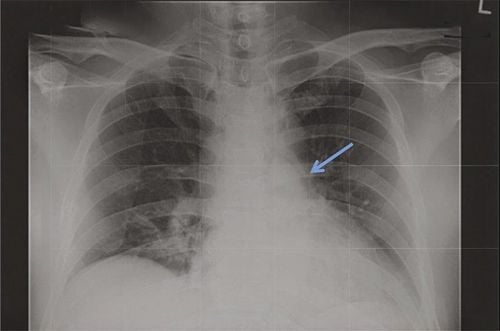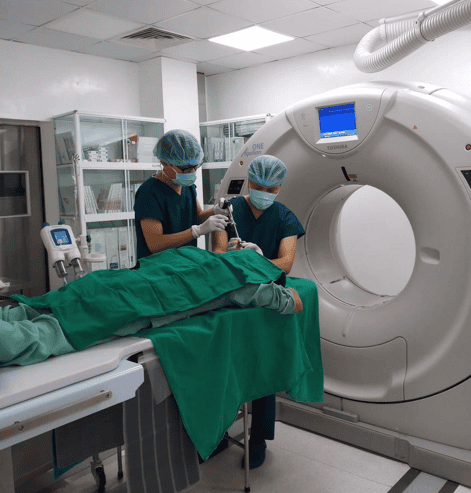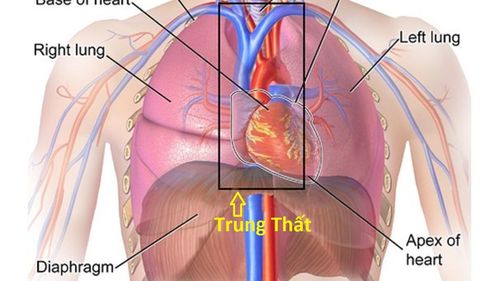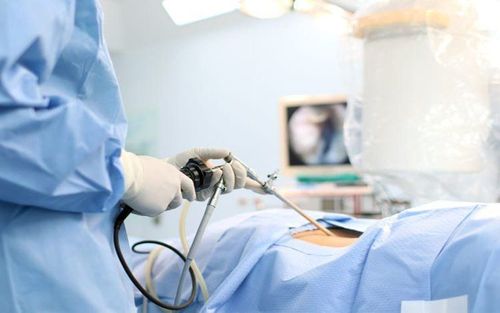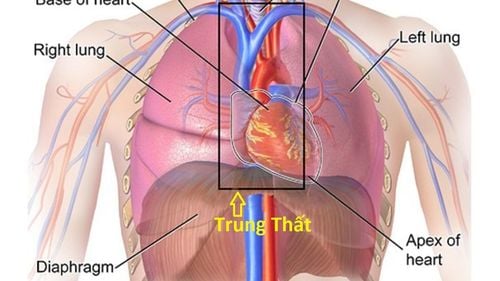This is an automatically translated article.
Mediastinal tumor will often grow silently and be difficult to detect, most cases of mediastinal tumor are discovered by chance during routine physical examination or when the disease has reached the late stage. At this time, thoracoscopic surgery to remove small mediastinal tumors is a must.
1. What is a mediastinal tumor?
Mediastinum is the center of the chest, inside the mediastinum are organs such as thymus gland, thoracic esophagus, heart, pericardium, large blood vessels and nerves...
Mediastinal tumor will appear occurs when germ cells or proliferative cells develop in thymus or neural or lymphoid tissue. Mediastinal tumors are located inside the thorax, and may be anterior or posterior to the mediastinum. It also accounts for 90% of mediastinal pathology.
Mediastinoma can be primary or secondary, it can form from benign or malignant overgrowth. Based on the origin of the formation of the cyst, this pathology is also classified into several types.
2. Manifestations of mediastinal tumor
Manifestations when mediastinal tumors appear are: Chest pain, shortness of breath when the patient is lying on his back. Difficulty breathing, wheezing, wheezing and possibly coughing up blood. If the tumor presses on the esophagus, the patient may have difficulty swallowing. In the long term, patients will experience fatigue, weight loss, body weakness, more severe respiratory infections, swelling and pain in the joints.
The extent of the anatomical lesion and the pathological disorder can sometimes be disproportionate, i.e. malignant tumors rarely present with symptoms and benign tumors present early and clearly.
Mediastinal tumor will grow over time and compress or invade other key organs such as the heart, lungs, blood vessels... This will impede circulation and breathing. Malignant tumors also have the ability to metastasize to the pericardium or lungs and threaten the patient's life.

U trung thất gây suy nhược cơ thể
3. What is mediastinoscopy?
Endoscopic mediastinal surgery is minimally invasive in the thorax to manage and treat pathology with the help of specialized endoscopic instruments and video monitors.
Mediastinoscopy is performed by making a small incision in the chest, creating an entrance to insert the mediastinoscopes into the chest. These endoscopes have cameras attached so that the doctor can see the images directly on the screen. During surgery, the surgeon may also conduct some tests if necessary. The doctor can take a small sample from the patient's chest and take it for testing to get the most accurate diagnosis.
3.1 Indications for thoracic surgery to remove mediastinal tumors
Cases diagnosed:
There is a mediastinal tumor with the size measured on computed tomography is small, less than 5cm. The tumor was either non-invasive or had minimally invaded nearby organs in the thorax or was a cystic tumor.
3.2 Contraindications
Cases of patients with contralateral lung damage and unable to conduct single-lung ventilation or people with severe systemic diseases will not be indicated for this surgery. Contraindicated for patients with blood disease, chronic disease, hemodynamic instability after trauma, previous chest trauma...
4. Perform thoracoscopic surgery for small mediastinal tumors less than 5cm
After preparing and performing the necessary operations, the surgeon will begin to perform the following surgical technique.
First, the doctor will use an electric knife to endoscopically dissect the tumor, ie remove the adhesions and burn the bleeding sites during surgery. The purpose of dissection is to clarify and access the vessels feeding the tumor to control it. The surgical procedure may require hemostasis clips or hemostasis stitches for large blood vessels. Mediastinal tumors located near the vena cava, thoracic duct or phrenic nerve... need to be very careful to avoid damaging these components. The surgeon removes the specimen from the pleural cavity, uses a special bag to send it to pathology. Then check the tightness of the tumor dissection area from the lung parenchyma and the tumor dissection area in the mediastinum... Check for apical air leak by pouring sterile blood into the pleural cavity and then inflating the lung to test. If there is still air leakage through the apex, it must be sutured immediately. Then drain the water to check the area of mediastinal dissection. If there is bleeding, stitches or endoscopic electrocautery are required to handle it. Finally, stop the trocar bleeding, re-irrigate the chest, then place a silicon drain inside the pleural cavity and continuously aspirate the drainage to prevent blockage due to blood clots. Then close the small opening, close the trocar holes after good lung expansion.

Sau phẫu thuật, có thể xảy ra tai biến như đau ngực dữ dội
5. Does thoracoscopy, mediastinal resection leave complications?
Most laparoscopic mediastinal resection surgery leaves no complications. In rare cases, the endoscope can press on a nerve temporarily causing the patient to become hoarse, sometimes this condition can be irreversible.
The patient may lose too much blood during the endoscopic procedure and need a blood transfusion or conversion to open surgery. With that gas, the patient may be at risk of pneumothorax, which is a leak of air from inside the lung. At this time, the patient needs to be intervened with drains between the 2 ribs within a few days.
Other serious but rare complications are atelectasis and esophageal laceration.
After surgery, if the patient encounters the following problems, they must immediately report to the doctor:
Bleeding from the incision site, a lot and for a long time High fever, hoarse voice that doesn't stop or signs of getting worse Severe pain in the chest, swelling in the neck, difficulty in swallowing and breathing, doctors always recommend that people should have regular health check-ups at reputable medical facilities to detect and promptly treat diseases. dangerous cause such as mediastinal tumor if present.
Any questions that need to be answered by a specialist doctor as well as customers wishing to be examined and treated at Vinmec International General Hospital, you can contact Vinmec Health System nationwide or register online HERE.




